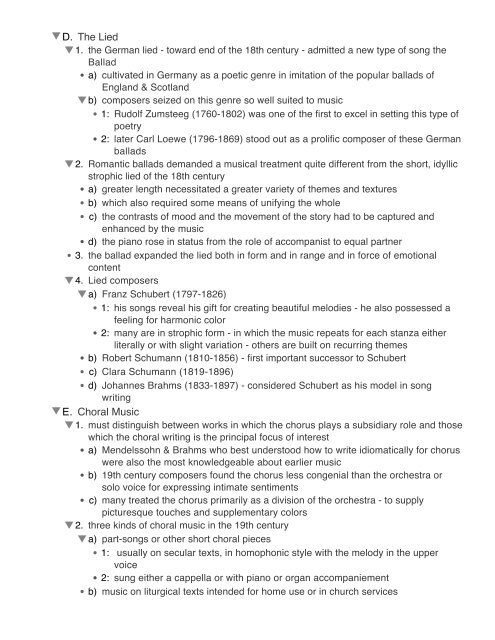An Outline of The History of Western Music Grout ... - The Reel Score
An Outline of The History of Western Music Grout ... - The Reel Score
An Outline of The History of Western Music Grout ... - The Reel Score
You also want an ePaper? Increase the reach of your titles
YUMPU automatically turns print PDFs into web optimized ePapers that Google loves.
D. <strong>The</strong> Lied<br />
1. the German lied - toward end <strong>of</strong> the 18th century - admitted a new type <strong>of</strong> song the<br />
Ballad<br />
a) cultivated in Germany as a poetic genre in imitation <strong>of</strong> the popular ballads <strong>of</strong><br />
England & Scotland<br />
b) composers seized on this genre so well suited to music<br />
1: Rudolf Zumsteeg (1760-1802) was one <strong>of</strong> the first to excel in setting this type <strong>of</strong><br />
poetry<br />
2: later Carl Loewe (1796-1869) stood out as a prolific composer <strong>of</strong> these German<br />
ballads<br />
2. Romantic ballads demanded a musical treatment quite different from the short, idyllic<br />
strophic lied <strong>of</strong> the 18th century<br />
a) greater length necessitated a greater variety <strong>of</strong> themes and textures<br />
b) which also required some means <strong>of</strong> unifying the whole<br />
c) the contrasts <strong>of</strong> mood and the movement <strong>of</strong> the story had to be captured and<br />
enhanced by the music<br />
d) the piano rose in status from the role <strong>of</strong> accompanist to equal partner<br />
3. the ballad expanded the lied both in form and in range and in force <strong>of</strong> emotional<br />
content<br />
4. Lied composers<br />
a) Franz Schubert (1797-1826)<br />
1: his songs reveal his gift for creating beautiful melodies - he also possessed a<br />
feeling for harmonic color<br />
2: many are in strophic form - in which the music repeats for each stanza either<br />
literally or with slight variation - others are built on recurring themes<br />
b) Robert Schumann (1810-1856) - first important successor to Schubert<br />
c) Clara Schumann (1819-1896)<br />
d) Johannes Brahms (1833-1897) - considered Schubert as his model in song<br />
writing<br />
E. Choral <strong>Music</strong><br />
1. must distinguish between works in which the chorus plays a subsidiary role and those<br />
which the choral writing is the principal focus <strong>of</strong> interest<br />
a) Mendelssohn & Brahms who best understood how to write idiomatically for chorus<br />
were also the most knowledgeable about earlier music<br />
b) 19th century composers found the chorus less congenial than the orchestra or<br />
solo voice for expressing intimate sentiments<br />
c) many treated the chorus primarily as a division <strong>of</strong> the orchestra - to supply<br />
picturesque touches and supplementary colors<br />
2. three kinds <strong>of</strong> choral music in the 19th century<br />
a) part-songs or other short choral pieces<br />
1: usually on secular texts, in homophonic style with the melody in the upper<br />
voice<br />
2: sung either a cappella or with piano or organ accompaniement<br />
b) music on liturgical texts intended for home use or in church services<br />
c) works for chorus & orchestra





